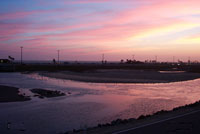|
Project: Coastal Water Quality
PI: Stanley B. Grant, Chem Eng & Mat Sci, UCI; Brett
F. Sanders, Civ & Envir Eng, UCI; Richard F. Ambrose, Envir Sci &
Eng, UCLA; and Clinton Winant and Lisa Levin, UCSD/SIO
Funding: UC Council Coastal Environmental Quality
Initiative
Division: UCI
Corporate Partners: Southern California Edison
Start Date: July 1, 2002
|
| >
|
California's economy depends heavily on tourism, and large numbers
of tourists of course are drawn to California because of the state's
beaches. But many beaches are not safe for swimming due to runoff
pollution from neighboring watersheds.
This interdisciplinary team is conducting studies to understand
the role that coastal wetlands play in modulating the input of fecal
indicator bacteria (FIB) into southern California's coastal waters.
FIB are important because they may indicate the presence of coastal
pollution (sewage, agricultural runoff, and stormwater runoff),
they are correlated with whether it's safe to swim, and they are
used as a water-quality index by state and local officials for decisions
regarding beach closures. Coastal wetlands are located at the outlet
of many urban watersheds along the southern California coastline
and, because of their location between urban watersheds and the
ocean, they are uniquely situated to mitigate the impacts of land
runoff on coastal pollution.
The team is testing two hypotheses: (1) The degree to which a coastal
wetland removes FIB from land runoff depends on the wetland's structure
and ecology, the nature of water circulation within the wetland,
and the tidal exchange of water between the wetland and the ocean;
and (2) The input of FIB into a wetland from land runoff depends
on specific features of the surrounding watershed. In addition,
the team anticipates that the features that most affect FIB loadings
from watersheds will be different during dry and wet weather seasons.
Their research involves field work, data analysis, and numerical
modeling.
"In addition to our fecal bacteria indictor studies, we monitor
runoff caused by storms. The vast majority of pollutants get
eroded during storms, flowing out of the watershed into the
ocean. We can work with satellite experts to track these pollution
plumes in the ocean, with the long-term goal of providing to
the public near-real-time information on coastal water quality.
These plumes show up on the satellite images, and, because the
water flowing out of the watersheds during storms is so turbid,
it looks like raging chocolate milk."
- Stan Grant, PI, UCI |
This project
leveraged a unique opportunity: In November 2001, the outlet of
the San Dieguito Lagoon (Del Mar, CA), a regionally important tidal
salt water marsh in San Diego County, became blocked with sand during
a large wave storm. Over the next several months, water quality
inside the lagoon steadily worsened due to declining dissolved oxygen
concentrations, declining salinity, and increasingly frequent fish
kills. This deterioration was believed to be caused by the absence
of tidal flushing plus the accumulation of nutrient-laden runoff
from the surrounding area, which includes the Del Mar Race Track
and Fairgrounds, many horse stables, and a large residential community.
Eleven months later, on October 4, 2002, the City of Del Mar excavated
(breached) the outlet. This event enabled the research team to conduct
before-and-after studies to learn more about the cleansing impacts
of tidal flushing.
Using this opportunity, the team characterized water circulation
in the lagoon and inshore region of the ocean; studied the temporal
evolution of FIB in the lagoon, surf zone, and offshore; measured
the spatial distribution of FIB in lagoon sediments, the relationship
between FIB-laden sediment and landscape features, and the ecological
response of the wetlands to the breach event; and studied linkages
between patterns of FIB occurrence and within-wetland circulation
via hydrodynamic modeling.
The breach occurred in conditions characterized by unusually small
waves, and weak littoral and inshore currents. As a result, contaminants
from the lagoon effluent were taken offshore initially, and some
fraction appears to have been recycled back into the surf zone by
shoreward-directed currents. The breach caused significant change
in the spatial distribution of FIB in the lagoon, along the shoreline,
and offshore. Before the breach, the highest concentrations of FIB
were observed at the site closest to the tidal outlet (associated
with low-salinity water and "nuisance" runoff from the horse stables).
The FIB gradient reversed several days after the breach with concentrations
increasing with increased distance inland. Within 24 hours of the
breach, FIB from the lagoon were detected over a 4 km2 area offshore,
stretching some 4 kilometers along shore and 1.2 km off shore. Consistent
with the calm ocean conditions the day of the breach, the FIB plume
was most concentrated just offshore of the tidal outlet. The concentration
of FIB in tidal sediments decreased after the breach but only after
the outlet had been open to tidal flushing for about one month.
FIB concentrations in the lower marsh areas remained low and showed
no apparent response to the breach.
Year 2 follow-up studies are being planned and are likely to include
studies at the upstream and downstream margins of the lagoon to
determine whether the wetland is producing or consuming FIB; measurement
of the export rate of FIB from a small constructed wetland in Mission
Bay (San Diego); and another breach study at Malibu Lagoon (Los
Angeles County).
Contact: Stanley B. Grant, sbgrant@uci.edu, 949-824-7320,
coast.eng.uci.edu
|

